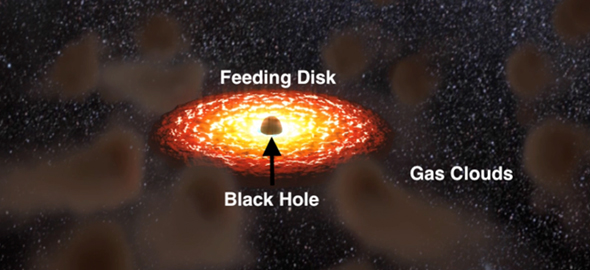Astronomers improve the most widely used method to measure masses of supermassive black holes
Tuesday, 21 November 2017
 Julián Mejía Astronomer DAS - U of Chile |
 Paulina Lira Astronomer DAS - U of Chile |
The finding will allow a deeper understanding of how supermassive black holes and galaxies relate are related to each other. The study was published by the journal Nature Astronomy in its edition of November 20, 2017.
There is a consensus in the scientific community that every galaxy - including our Milky Way - contains a giant, or supermassive, black hole at its center. Therefore, determining their mass is essential to understand how much they influence their galactic environment. But getting this information is not simple.
So far, the most widely used method by the scientific community consists in analyzing the emissions from gas clouds found in the vicinity of the disk that feeds the black hole. This is a disk of incandescent material that can be as bright as all the stars in the galaxy together. The disk is formed when a black hole becomes `active’ and swallows material that down-spirals towards it, feeding it. However, the accuracy of this method depends to a large extent on the way the gas clouds are distributed, information which is almost always unknown.
A research led by Julián Mejía-Restrepo and Paulina Lira, astronomers of the FCFM at the University of Chile established a simple way to correct and significantly reduce the errors of the mass calculations, some of which reach up to a correction by a factor of 6 times the real mass. The research was carried out in collaboration with Hagai Netzer from the Tel Aviv University in Israel, Benny Trakhtenbrot from the ETH institute in Switzerland, and Daniel Capellupo from the McGill University in Canada.
The research consisted in the study of 40 quasars using the X-Shooter instrument at the Very Large Telescope of ESO located in Cerro Paranal, near Antofagasta. This spectrograph simultaneously covers a very wide range of wavelengths (from the UV to the near-infrared), and allowed them to measure accurately the emission of the feeding disks of the black holes observed.
The way the feeding disk emits radiation gives us information about the mass of the black hole. On the other hand, the emission from the gas clouds can also be used to determine black hole masses, but the measurements strongly depend on how these clouds are distributed”. Mejía explains.
“Since the masses obtained by studying the disk emission do not depend on the properties of the gas clouds, when comparing both mass estimates, we were able to derive some clues about the cloud distribution and obtain a simple way to noticeably correct the black hole masses derived from the gas cloud information, which is the technique most commonly used by the astronomical community”, he continues.
The analysis of our results allowed us to infer that the gas clouds near the black hole are organized in a flat and thin structure and/or that they are being disturbed by the intensity of the radiation coming from the disk," says Mejía.
Hagai Netzer, from Tel Aviv University, who has been working on black hole mass measurements for many years, noted that “the new method can help to unveil the connections between such objects, and their host galaxies, at very early times, when the universe age was less than 4 billion years”.
 Credits: Ricardo Ramírez. |




